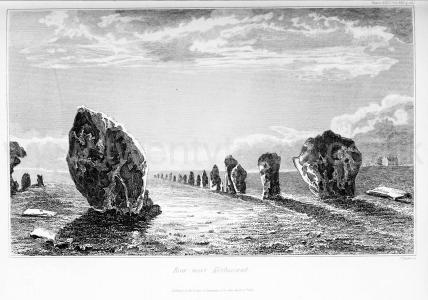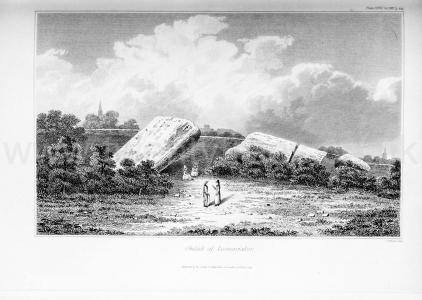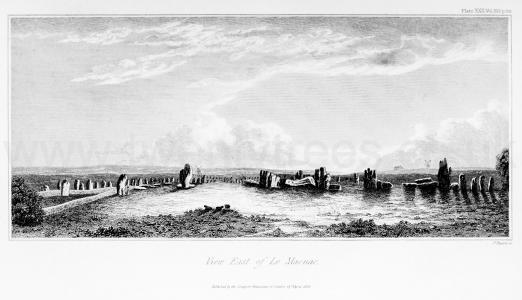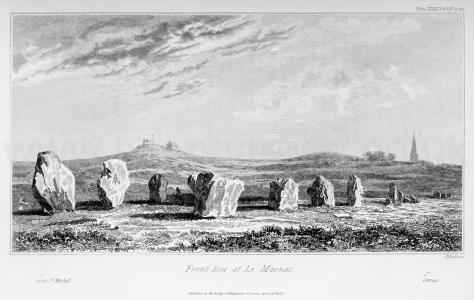Prehistoric Brittany Stones
Prehistoric Brittany Stones is in Prehistoric Brittany.
Europe, France, Brittany, Carnac, Kerlescan Stone Rows [Map]
Archaeologia Volume 25 Section XII. Kerlescan Stone Rows [Map].

Europe, France, Brittany, Morbihan, Locmariaquer, Menhir Er Grah [Map]
Archaeologia Volume 25 Section XIII. 3. The third species of monument remaining at Locmariaker is the round Obelisk [Menhir Er Grah [Map]]. A beautiful one stood at the head of Caesar's tumulus; and it was sixty-three feet in length and fourteen feet in diameter at the thickest part, which is at about twenty feet from the base. From this point it tapers gradually both ways. Another obelisk, about thirty-five feet in length, lies at the entrance of the village; its tumulus was perhaps removed to make room for a house. Each of these is cut out of a single stone.
These obelisks probably denoted the burial-places of warriors of the first rank: and may have originated in the well-known custom still prevalent in the East, of planting an upright spear at the head of a Chief as he slept upon the ground. It was thus that David found Saul on the hill of Hachilah: "Behold Saul lay sleeping within the trench, and his spear stuck in the ground at his bolster."a This custom was universal in the East. Homer mentions it, and it has been repeatedly observed by travellers in Persia and Hindustan. The spear at the head, thus planted, always denotes a warrior of the highest rank.
Some mighty Celtic chief may in like manner be supposed to be sleeping at Locmariaker, under the tumulus of Caesar, "with his spear stuck in the ground at his bolster: "only the sleep being that of death, the spear is of a material of corresponding duration; it is an obelisk of stone cut out of a single block.
The evangelizers of Britany, for they probably were the destroyers, suffered not the warrior's spear to mark his last resting-place. The obelisk was overthrown, as an object of superstitious veneration, and now lies broken in four pieces. The tomb also has been rifled of its sacred deposit; and the whole is but a variety of the continual work of ruin which in every country records the mutability of man, and the vanity of his earthly hopes.
The original weight of this column must have been about 260 tons! and the labour required to remove it from the quarry and to plant it at the head of the tumulus of Caesar may be imagined, by calling to our recollection the power employed by Fontana to place the obelisk of the Vatican in its present site at Rome. The latter column was only fifteen feet longer than the obelisk before us; and, although it weighed only 150 tons, whereas that of Locmariaker weighed 26 0, yet it required the united efforts of eight hundred men and sixty horses, complex machinery, and the expenditure of ^*5000, to remove it for a short distance, and erect it as it now stands! We should also recollect that the erection of the obelisk of Locmariaker was the work of a rude age, ignorant, probably, of the mechanical powers, and mainly effected by human strength.
Note a. 1 Samuel, xxvi. 7.

Archaeologia Volume 32 Appendix. Cromlech and Obelisk at Locmariaker in Britanny.
11th March, 1847. William Bromet, Esq. M.D. F.S.A. in a Letter to the Director, remarks, that having called attention to the somewhat exaggerated views of a Cromlech and Obelisk [Menhir Er Grah [Map]] in Britanny, presented some years ago to the Society by the Rev. J. Bathurst Deane, he now exhibits another Drawing of this Cromlech or Dolmen, as it is called in its neighbourhood; and also a Drawing of the Interior of the Cavern under the tumulus Gaur' Innis. The upper or table stone of the Cromlech, according to Dr. Bromet's own measurement, is twenty-one feet long, twelve broad, and four deep; it is supported by three vertical stones which are between five and six feet above ground; and there is another and shorter vertical stone, which, although not a supporter, was evidently erected for the purpose of its becoming so, should either of the three other uprights fail — a provision observed in similar Antiquities in Cornwall. The Obelisk, or Menhir, has long been in a fallen and fractured state; it consists of four pieces, altogether more than seventy feet long, and at its largest end fourteen feet broad, with an estimated weight of two hundred and fifty tons.
Europe, France, Brittany, Carnac, Ménec Stone Rows [Map]
Archaeologia Volume 25 Section XII. Ménec Stone Rows [Map].

